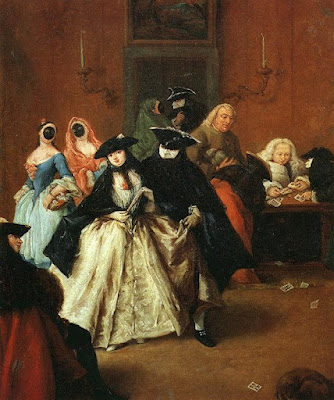The Mask in 17th Century Venice by Deborah Swift
When I decided to set The Fortune Keeper in Venice in the 17th century, I was aware of the carnival season and the revels and disguises in my novel, and knew that the timeline would fit neatly with the two previous books. The plot of the novel features an assassin, and I realised the masked celebrations of Carnival would be an ideal place for this character to hide in plain sight.
Every day mask-wearing seemed to begin as a form of politeness in business or at the gaming table. Large amounts of money passed through Venice in the golden age of sail, as it was a centre for trade between east and west. Talk of money, and negotiations over assets, were often easier when the face could assume a neutral appearance. Soon mask wearing in Venice became widely understood to be indicative of high status; a maintainer of propriety, a device used by the nobility which, rather than aiming to deceive, was designed to preserve the status quo. When rich people adopt something, they soon have imitators, and the mask quickly became common attire. The exception being that masks were still forbidden in churches and convents, probably because these were the repositories of wealth, as well as holy places.
In the early 17tth century after several incidents of murders by masked men, the Council of Ten banned carrying a weapon when masked. Town guards were asked to frisk maskers for weapons, but these searches became so common they soon became cursory, and there was no guarantee a masked man would not be armed.
In the late Renaissance, women were often masked for modesty, and this led to a law that forbade prostitutes from wearing the mask. In 1608 any ‘woman of ill-repute’ found wearing one would be chained between the columns in the Piazetta at San Marco, whipped, and banned from the city for four years. Yet only a hundred years later, when masking had become de rigueur, prostitutes were actually required by law to wear masks in public.
By the 1770’s and 80’s the laws on mask wearing were so unclear that compliance to the law became almost impossible to enforce. There were laws, but no-one took any notice of them. In that respect, it was like the recent Covid mask-wearing; there was guidance and advice, or soft laws, which were widely interpreted in different ways. People rebelled as they saw the enforcing of mask-wearing laws as an attempt to control the population at a time of the city’s rapid expansion.
For the authorities, controlling mask-wearing was an attempt to make sure people knew who was in charge – and an example of this is the State Inquisitors who passed a law saying, ‘no patrician may enter the theatre or the orchestra seats unless masked.’ The key here is the word ‘patrician’— as it was clearly an attempt through masking, and the sumptuary (clothing) laws, to define and reinforce the upper classes.
As well as the difficulties for a novelist of when a person should be masked, and what the penalties might be for murder, the other difficulty was technical. Most masks worn by nobles were the bauta, the full mask and tricorn. For women, the moretta mask which covered the whole face, and was held between the teeth by a button, was common. It struck me that the lack of facial expression must mean reliance on gesture must have been mandatory for most maskers. In certain situations, my protagonist wouldn’t be able to ‘raise an eyebrow’, ‘blush’ or ‘smile’.
Nevertheless, the mask phenomenon in Venice, and its connection to crime, is absolutely fascinating. I can heartily recommend the book, ‘Venice Incognito – Masks in the Serene Republic’ by James H Johnson for anyone who wants to know more about masks and the class hierarchies in Venice.
Bibliography
Venice Incognito – Masks in the Serene Republic James H Johnson
Working Women of Early Modern Venice Monica Chojnacka
Law and Punishment in Early Renaissance Venice – Guido Ruggiero
By Deborah Swift

.jpg)











Thank you so much for hosting Deborah Swift today. What a fascinating post!
ReplyDeleteTake care,
Cathie xx
The Coffee Pot Book Club